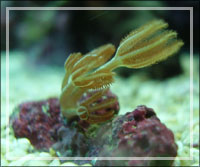Xenia, Clove Polyps And Waving Hand Polyps

Xenias have become one of the most common corals in the
aquarium trade and this common name applies to many soft corals these
days. Today however we will be concentrating on one more commonly known
as Pulsing, Red Sea or Pom Pom Xenia.
The easiest way of fragging Xenia is actually to let it do the work for you; this can be achieved easily by laying pieces of live-rock or ocean rock around the base of the colony on the opposite side to the direction of water flow. The Xenia will then spread out onto the rocks and the frag can then be removed by cutting the adjoining foot with a blade. The remaining tissue left behind will re-grow into a new colony. In addition to being an excellent way to propagate Xenia, it's also effective for preventing Xenia from spreading excessively and overgrowing other corals. In my experience these species of xenia are best propagated using this technique because they can be difficult to handle once disturbed.
The easiest way to attach the fragment is use a rubber-band to affix its foot to a piece of live rock, but not to be so tight that it will crush or sever the coral’s tissue. A safer way would be to use a needle and a thread of fishing line. You can pierce the needle through the bottom of the colonies foot and tie it down easily to a piece of rock. Once the coral has grown on, the line can be cut out and removed.
You can also simply cut stems of xenia from your live rock and place into a pond plant basket or breeding trap along with some pieces of rock. If the xenia cannot be blown away its location then it will attach to the closest piece of rock very quickly.
The easiest way of fragging Xenia is actually to let it do the work for you; this can be achieved easily by laying pieces of live-rock or ocean rock around the base of the colony on the opposite side to the direction of water flow. The Xenia will then spread out onto the rocks and the frag can then be removed by cutting the adjoining foot with a blade. The remaining tissue left behind will re-grow into a new colony. In addition to being an excellent way to propagate Xenia, it's also effective for preventing Xenia from spreading excessively and overgrowing other corals. In my experience these species of xenia are best propagated using this technique because they can be difficult to handle once disturbed.
The easiest way to attach the fragment is use a rubber-band to affix its foot to a piece of live rock, but not to be so tight that it will crush or sever the coral’s tissue. A safer way would be to use a needle and a thread of fishing line. You can pierce the needle through the bottom of the colonies foot and tie it down easily to a piece of rock. Once the coral has grown on, the line can be cut out and removed.
You can also simply cut stems of xenia from your live rock and place into a pond plant basket or breeding trap along with some pieces of rock. If the xenia cannot be blown away its location then it will attach to the closest piece of rock very quickly.
PROPAGATING WAVING HAND CORAL
This is problem coral to propagate using the super glue method.
- Remove six or more polyps along with a piece of the base rock with a sharp chisel.
- Apply a drop of glue to the base rock holding the polyp
- Hold the polyp on the rock for 10 seconds and place the cutting in the water
PROPAGATING CLOVE POLYP CORAL THE CORAL WE HAVE RECEIVED AS CLOVE POLYPS SEEMS TO BE A CESPITULRIA.
This coral looks like a robust Anthelia. The stocks of the polyps are jointed, and the polyps do not retract all of the way in.
This is an easy coral to propagate using the super glue method.
- Remove one or more polyps from the base rock with a sharp chisel.
- Apply a drop of glue to the base of the polyp
- Hold the polyp on the rock for 10 seconds and place the cutting in the water
Polyp Eating Starfish

Remove these starfish as soon as you see them.
These quickly get out of control and eat most types of polyps.
Harlequin shrimp are excellent in removing these for you!
These quickly get out of control and eat most types of polyps.
Harlequin shrimp are excellent in removing these for you!
Clove Polyp Eating Nudibrach

Eliminate all of these as quickly and carefully as possible.
They usually disappear after the cloves are removed.
Reef Dip your clove polyp colony.
They usually disappear after the cloves are removed.
Reef Dip your clove polyp colony.
